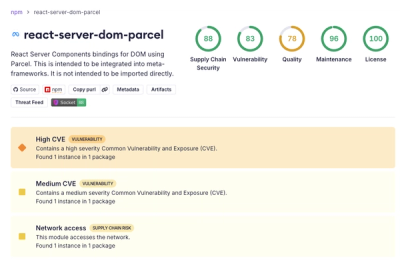
Security News
Deno 2.6 + Socket: Supply Chain Defense In Your CLI
Deno 2.6 introduces deno audit with a new --socket flag that plugs directly into Socket to bring supply chain security checks into the Deno CLI.
@matrixai/async-cancellable
Advanced tools
This library provides the ability to cancel asynchronous tasks. Cancelling asynchronous tasks was never standardised in JavaScript. This was due to the myriad complexity of cancellation illustrated by https://github.com/tc39/proposal-cancellation:
The following are some architectural observations provided by Dean Tribble on the es-discuss mailing list:
Cancel requests, not results
Promises are like object references for async; any particular promise might be returned or passed to more than one client. Usually, programmers would be surprised if a returned or passed in reference just got ripped out from under them by another client. this is especially obvious when considering a library that gets a promise passed into it. Using "cancel" on the promise is like having delete on object references; it's dangerous to use, and unreliable to have used by others.
Cancellation is heterogeneous
It can be misleading to think about canceling a single activity. In most systems, when cancellation happens, many unrelated tasks may need to be cancelled for the same reason. For example, if a user hits a stop button on a large incremental query after they see the first few results, what should happen?
- the async fetch of more query results should be terminated and the connection closed
- background computation to process the remote results into renderable form should be stopped
- rendering of not-yet rendered content should be stopped. this might include retrieval of secondary content for the items no longer of interest (e.g., album covers for the songs found by a complicated content search)
- the animation of "loading more" should be stopped, and should be replaced with "user cancelled"
- etc.
Some of these are different levels of abstraction, and for any non-trivial application, there isn't a single piece of code that can know to terminate all these activities. This kind of system also requires that cancellation support is consistent across many very different types of components. But if each activity takes a cancellationToken, in the above example, they just get passed the one that would be cancelled if the user hits stop and the right thing happens.
Cancellation should be smart
Libraries can and should be smart about how they cancel. In the case of an async query, once the result of a query from the server has come back, it may make sense to finish parsing and caching it rather than just reflexively discarding it. In the case of a brokerage system, for example, the round trip to the servers to get recent data is the expensive part. Once that's been kicked off and a result is coming back, having it available in a local cache in case the user asks again is efficient. If the application spawned another worker, it may be more efficient to let the worker complete (so that you can reuse it) rather than abruptly terminate it (requiring discarding of the running worker and cached state).
Cancellation is a race
In an async system, new activities may be getting continuously scheduled by asks that are themselves scheduled but not currently running. The act of cancelling needs to run in this environment. When cancel starts, you can think of it as a signal racing out to catch up with all the computations launched to achieve the now-cancelled objective. Some of those may choose to complete (see the caching example above). Some may potentially keep launching more work before that work itself gets signaled (yeah it's a bug but people write buggy code). In an async system, cancellation is not prompt. Thus, it's infeasible to ask "has cancellation finished?" because that's not a well defined state. Indeed, there can be code scheduled that should and does not get cancelled (e.g., the result processor for a pub/sub system), but that schedules work that will be cancelled (parse the publication of an update to the now-cancelled query).
Cancellation is "don't care"
Because smart cancellation sometimes doesn't stop anything and in an async environment, cancellation is racing with progress, it is at most "best efforts". When a set of computations are cancelled, the party canceling the activities is saying "I no longer care whether this completes". That is importantly different from saying "I want to prevent this from completing". The former is broadly usable resource reduction. The latter is only usefully achieved in systems with expensive engineering around atomicity and transactions. It was amazing how much simpler cancellation logic becomes when it's "don't care".
Cancellation requires separation of concerns
In the pattern where more than one thing gets cancelled, the source of the cancellation is rarely one of the things to be cancelled. It would be a surprise if a library called for a cancellable activity (load this image) cancelled an unrelated server query just because they cared about the same cancellation event. I find it interesting that the separation between cancellation token and cancellation source mirrors that separation between a promise and it's resolver.
Cancellation recovery is transient
As a task progresses, the cleanup action may change. In the example above, if the data table requests more results upon scrolling, it's cancellation behavior when there's an outstanding query for more data is likely to be quite different than when it's got everything it needs displayed for the current page. That's the reason why the "register" method returns a capability to unregister the action.
This library attempts to address each concern.
AbortController, this allows the user to define how cancellation should propagate through the applicationPromiseCancellable.then binding, both the the fulfilled and rejected handler takes the signal: AbortSignal, here it is possible to customise the logic of fulfillment and rejection depending on the situation, therefore cancellation can be as smart as you want it to beAbortSignal, one cannot ask if cancellation is finished, it is purely an event driven systemPromiseCancellation.cancel is purely advisory, the default behaviour is that the immediate promise is rejected early, however this can be customised, therefore the default intention is that the promise can be rejected with the cancellation reason, and means you don't care about the result anymore, it does not imply anything stronger than thisPromiseCancellable.then, PromiseCancellable.catch and PromiseCancellable.finally, the signal is passed in, it is possible to change how you cancel depending on what the current situation is.npm install --save @matrixai/async-cancellable
Run nix develop, and once you're inside, you can use:
# install (or reinstall packages from package.json)
npm install
# build the dist
npm run build
# run the repl (this allows you to import from ./src)
npm run tsx
# run the tests
npm run test
# lint the source code
npm run lint
# automatically fix the source
npm run lintfix
npm run docs
See the docs at: https://matrixai.github.io/js-async-cancellable/
Publishing is handled automatically by the staging pipeline.
Prerelease:
# npm login
npm version prepatch --preid alpha # premajor/preminor/prepatch
git push --follow-tags
Release:
# npm login
npm version patch # major/minor/patch
git push --follow-tags
Manually:
# npm login
npm version patch # major/minor/patch
npm run build
npm publish --access public
git push
git push --tags
FAQs
Asynchronous Cancellation
We found that @matrixai/async-cancellable demonstrated a healthy version release cadence and project activity because the last version was released less than a year ago. It has 3 open source maintainers collaborating on the project.
Did you know?

Socket for GitHub automatically highlights issues in each pull request and monitors the health of all your open source dependencies. Discover the contents of your packages and block harmful activity before you install or update your dependencies.

Security News
Deno 2.6 introduces deno audit with a new --socket flag that plugs directly into Socket to bring supply chain security checks into the Deno CLI.

Security News
New DoS and source code exposure bugs in React Server Components and Next.js: what’s affected and how to update safely.

Security News
Socket CEO Feross Aboukhadijeh joins Software Engineering Daily to discuss modern software supply chain attacks and rising AI-driven security risks.